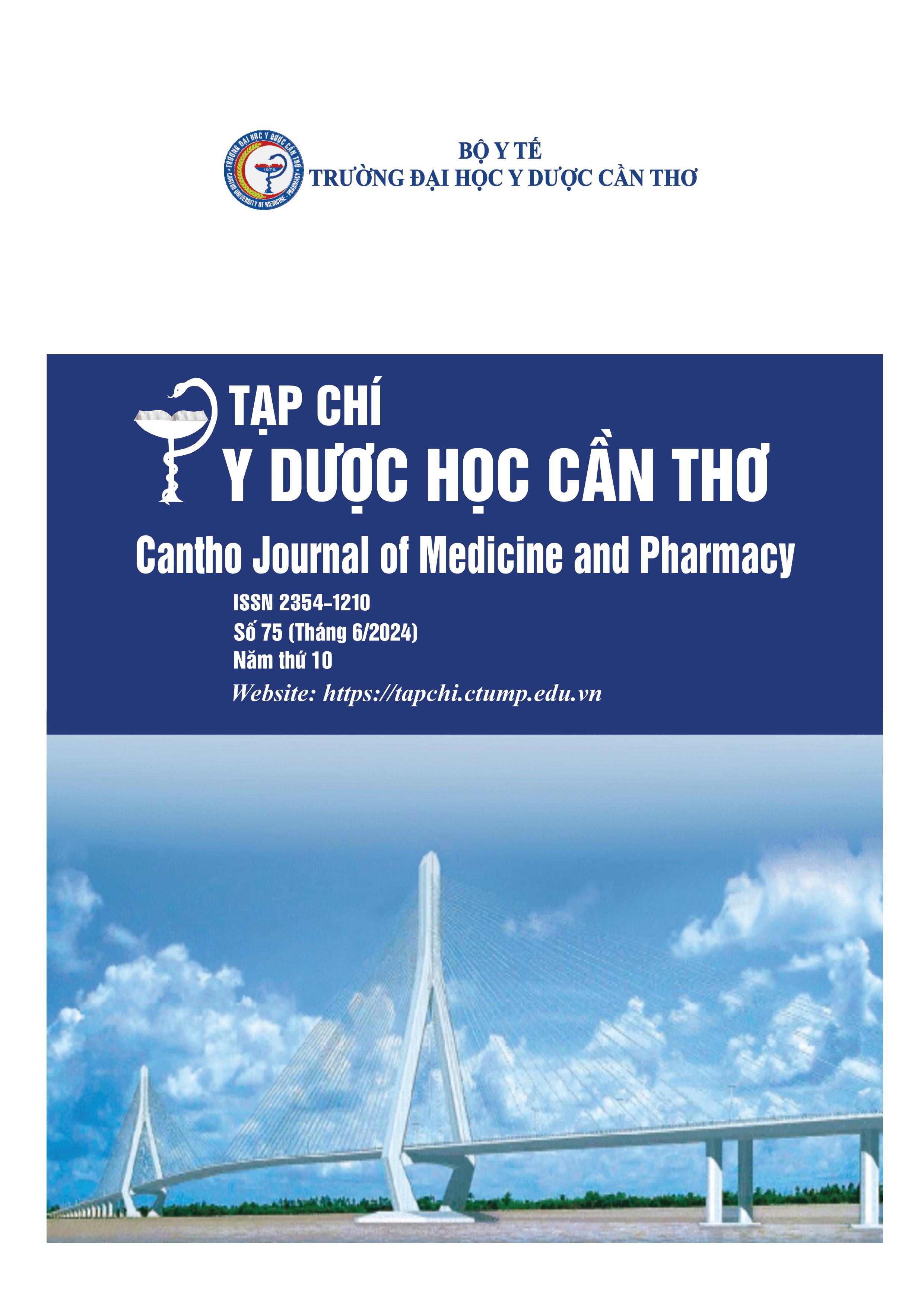THE CHARACTERISTICS OF THE MTHFR C677T GENE POLYMORPHISM, BLOOD HOMOCYSTEINE LEVELS AND THEIR RELATIONSHIP WITH SOME CARDIOVASCULAR RISK FACTORS IN TYPE 2 DIABETES PATIENTS
Main Article Content
Abstract
Background: The MTHFR C677T polymorphism leads to a decrease in MTHFR concentration, thereby increasing the blood levels of Homocysteine (Hcy). Elevated Hcy levels predict the risk of mortality or cardiovascular events in type 2 diabetes mellitus (T2DM) patients. Significantly higher levels of Hcy were observed in individuals carrying the MTHFR C677T gene polymorphism. Objectives: To investigate the characteristics of the MTHFR C677T polymorphism, Homocysteine levels, and their correlation with some cardiovascular risk factors in type 2 diabetes mellitus patients. Materials and method: A cross-sectional descriptive study conducted on 89 type
2 diabetes mellitus patients at Can Tho University of Medicine and Pharmacy Hospital. Results:
The frequency of the 677CC, 677CT, and 677TT genotypes in the type 2 diabetes mellitus patients was 66.3%, 28.1%, and 5.6%, respectively. The frequency of the T allele was 19.7%. The average blood Hcy concentration in type 2 diabetes mellitus patients with the TT genotype were significantly higher at 21.1 ± 30.2 µmol/L compared to those with the CC genotype at 8.12 ± 4.56 µmol/L and CT genotype at 8.91 ± 2.72 µmol/L (p < 0.05). The duration of type 2 diabetes mellitus and the TT genotype were independent factors significantly influencing blood Hcy levels. Conclusion: The CC genotype of the MTHFR C677T polymorphism has the highest prevalence, followed by CT and TT genotypes. The frequency of the C allele was higher than that of the T allele. Blood Hcy levels were significantly higher in type 2 diabetes mellitus patients with the TT genotype compared to those with CC and CT genotypes. Patients with type 2 diabetes mellitus with a longer duration of the disease and the TT genotype have an increased risk of elevated blood Hcy levels.
Article Details
Keywords
MTHFR C677T, Homocysteine, diabetes type 2
References
10.3109/0886022x.2015.1064743.
2. Frosst P., Blom H.J., Milos R., Goyette P., Sheppard C.A., et al. A candidate genetic risk factor for vascular disease: a common mutation in methylenetetrahydrofolate reductase. Nat Genet. 1995. 10(1), 111-113, doi: 10.1038/ng0595-111.
3. Phạm Hồng Ngọc, Nguyễn Huy Bình và Nguyễn Thị Thu Hương. Nghiên cứu mối liên quan giữa đa hình kiểu gen MTHFR C677T với một số biến chứng ở bệnh nhân đái tháo đường type 2. Luận văn thạc sĩ y học khoa Sinh lý. Đại học Y Hà Nội. Hà Nội. 2017.
4. Nguyễn Bảo Hiền, Đoàn Văn Đệ và Nguyễn Văn Đàm. Khảo sát nồng độ, tỷ lệ biến đổi Homocystein huyết tương ở bệnh nhân đái tháo đường típ 2. Tạp chí Y học Việt Nam. 2022. 516(1), 44-48, doi: 10.51298/vmj.v516i1.2941.
5. Bùi Thế Long, Đoàn Văn Đệ và Bùi Mỹ Hạnh. Đặc điểm nồng độ Homocystein ở bệnh nhân đái tháo đường típ 2 có loét bàn chân. Tạp chí Y học Việt Nam. 2022. 512(1), 131-134, doi:
10.51298/vmj.v512i1.2212.
6. Yadav U., Kumar P., Gupta S. and Rai V. Distribution of MTHFR C677T Gene Polymorphism in Healthy North Indian Population and an Updated Meta-analysis. Indian J Clin Biochem. 2017. 32(4), 399-410, doi: 10.1007/s12291-016-0619-0.
7. Zhang S.-Y., Xuan C., Zhang X.-C., Zhu J., Yue K., et al. Association Between MTHFR Gene Common Variants, Serum Homocysteine, and Risk of Early-Onset Coronary Artery Disease: A Case– Control Study. Biochemical Genetics. 2020. 58(2), 245-256, doi: 10.1007/s10528-019-09937-x.
8. Gupta S.K., Kotwal J., Kotwal A., Dhall A. and Garg S. Role of homocysteine & MTHFR C677T gene polymorphism as risk factors for coronary artery disease in young Indians. Indian J Med Res. 2012. 135(4), 506-512, doi:
9. Russo G.T., Di Benedetto A., Giorda C., Alessi E., Crisafulli G., et al. Correlates of total homocysteine plasma concentration in type 2 diabetes. European Journal of Clinical Investigation. 2004. 34(3), 197-204, doi: 10.1111/j.1365-2362.2004.01319.x.
10. Zulfania, Khan A., Rehman S. and Ghaffar T. Association of homocysteine with body mass index, blood pressure, HbA1c and duration of diabetes in type 2 diabetics. Pak J Med Sci. 2018. 34(6), 1483-1487, doi: 10.12669/pjms.346.16032.
11. Nguyễn Thị Bích Chi và Hồ Anh Bình. Nghiên cứu nồng độ Homocystein máu ở bệnh nhân đái tháo đường týp 2 có tổn thương động mạch vành. Tạp Chí Y Học Lâm Sàng. 2021. 67, 34-46, doi: 10.38103/jcmhch.2021.67.6.
12. Held C., Sumner G., Sheridan P., McQueen M., Smith S., et al. Correlations between plasma homocysteine and folate concentrations and carotid atherosclerosis in high-risk individuals: baseline data from the Homocysteine and Atherosclerosis Reduction Trial (HART). Vasc Med. 2008. 13(4), 245-253, doi: 10.1177/1358863x08092102.
13. Platt D.E., Hariri E., Salameh P., Merhi M., Sabbah N., et al. Type II diabetes mellitus and hyperhomocysteinemia: a complex interaction. Diabetol Metab Syndr. 2017. 9, 19, doi:
10.1186/s13098-017-0218-0.
14. Wu K., Zhang S., Guan Z., Li X., Li R., et al. Methylenetetrahydrofolate Reductase Gene Polymorphism C677T is Associated with Increased Risk of Coronary Heart Disease in Chinese Type 2 Diabetic Patients. Chinese Medical Sciences Journal. 2021. 36(2), 103-109, doi: 10.24920/003792.


